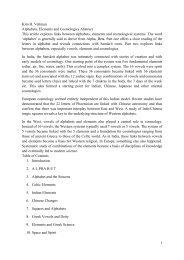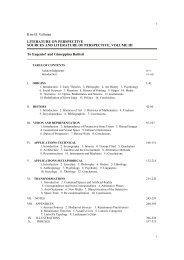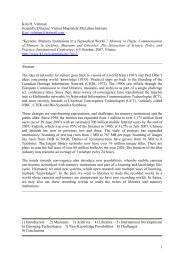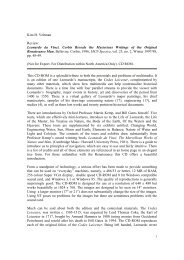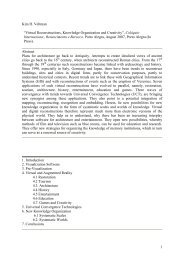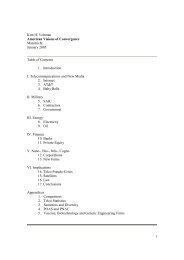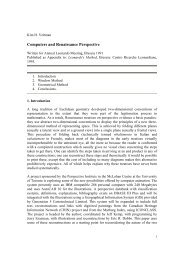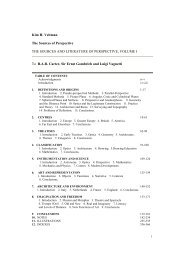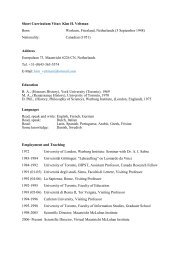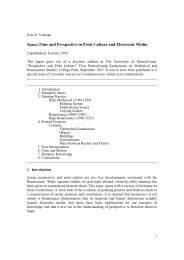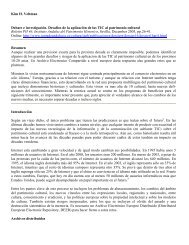1986 Perspective, Anamorphosis And Vision
1986 Perspective, Anamorphosis And Vision
1986 Perspective, Anamorphosis And Vision
Create successful ePaper yourself
Turn your PDF publications into a flip-book with our unique Google optimized e-Paper software.
8. Surveying and <strong>Perspective</strong><br />
From the outset there were close links between surveying and linear perspective. In<br />
Germany, it was assumed that the term „perspective" was synonymous with the „art of<br />
measurement". 37 Whence it is no coincidence that Dürer discusses perspective in his<br />
Underweysung der Messung (1525). At least since the time of Hero of Alexandria round<br />
tablets had been used for surveying purposes. 38 Alberti in the 15 th century described the<br />
use of such a round tablet in his Descriptio urbis Romae. Gerard de Jode (1594) 39<br />
describes the use of visual angles in surveying to record a scene or landscape.<br />
In 1508 Leonardo explores the systematic diminution of visual angles in surveying under<br />
the heading of perspective. 40 By 1583, Danti, in his edition of Vignola's treatise on<br />
perspective, notes how these visual angles diminish proportionally with distance. 41 An<br />
interplay between surveying and perspective thus helps to account for the origins of the<br />
proportional compass (cf. Galileo). Whence it is not surprising that several key figures at<br />
the turn of the seventeenth century, e.g. Guidobaldo del Monte, Jobst Bürgi and Levinus<br />
Hulsius, are writing both on perspective and proportional compasses. Nor is it surprising<br />
that such compasses should be used by the mathematician Vaulezard 42 for both<br />
perspectival and anamorphic drawings. Indeed a tradition emerges in which proportional<br />
compasses are discussed in connection with perspective (e.g. Lambert 43 ). In other words,<br />
the interplay of surveying and perspective led, though the proportional compass, to both<br />
linear perspectival and anamorphic projection methods.<br />
9. Surveying, <strong>Perspective</strong> and Cylindrical Projections<br />
The interplay between surveying and perspective also led to such circular tablets<br />
becoming linked with cylindrical projection methods. An example is Baldassare Lanci's<br />
instrument, dated 1567, now in the Museum for the History of Science in Florence (fig.<br />
30). It is partly intended to function as a traditional surveying instrument, as confirmed by<br />
its compass, two rods for measuring angles and the text inscribed around its<br />
circumference: “Agents and mathematicians can find use in this instrument both for<br />
geography and topography since it is especially easy with this kind of instrument to take<br />
any site whatever and have a perfect notation and make a picture of every distance." 44<br />
In addition the instrument has a series of small holes around its circumference designed<br />
for mounting a hemi-cylindrical projection plane which has since been lost (cf. fig. 31). In<br />
the centre of the circular tablet is a swivel device with a sighting tube and needle-like<br />
marker. This combination permits one to look through the sighting tube and trace its<br />
position directly onto the hemi-cylindrical projection plane.<br />
Daniele Barbaro saw this instrument - or one very much like it - at Baldassare Lanci's<br />
home and gives a published account of its use for drawing purposes in his treatise on<br />
perspective 45 (1569). Egnazio Danti, in his edition of Vignola's treatise, provides an<br />
illustration of the instrument as it once was (fig. 31), a detailed account of its use, plus a<br />
critique of its shortcomings. 46<br />
Danti mentions that Lanci's device “was used by many others". An unpublished drawing<br />
(fig. 32) by Johann Kretzmayer (Krezmaier), in a manuscript with extracts of treatises on<br />
15



